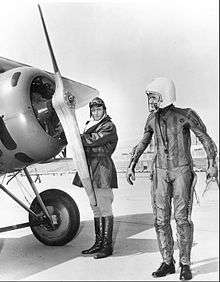The Last Flight (''The Twilight Zone'')
| "The Last Flight" | |
|---|---|
| The Twilight Zone episode | |
|
Scene from "The Last Flight" | |
| Episode no. |
Season 1 Episode 18 |
| Directed by | William Claxton |
| Written by | Richard Matheson (based on the short story "Flight") |
| Featured music | Stock from "Where Is Everybody?" by Bernard Herrmann |
| Production code | 173-3607 |
| Original air date | February 5, 1960 |
| Guest appearance(s) | |
| |
"The Last Flight" is episode 18 of the American television anthology series The Twilight Zone. Part of the production was filmed on location at Norton Air Force Base in San Bernardino, California. The vintage 1918 Nieuport 28 biplane was both owned and flown by Frank Gifford Tallman, and had previously appeared in many World War I motion pictures.
Plot
Flight Lieutenant William Terrance "Terry" Decker of 56 Squadron Royal Flying Corps lands his Nieuport biplane on an American airbase in France, after flying through a strange cloud. He is taken into custody and questioned by the American base commander, General Harper, and his provost marshal, Major Wilson. Decker identifies himself and his squadron and claims that the date is March 5, 1917. He is informed that it is actually March 5, 1959.
Decker tells the officers that he and his comrade Alexander Mackaye were fighting seven German aircraft; Mackaye was shot down and Decker escaped into a cloud. The Americans tell him that Mackaye is alive and is an Air Vice Marshal in the Royal Air Force, having saved thousands of lives during World War II by shooting down German bombers over London. Mackaye is coming to inspect the base that day. Major Wilson tries to help Decker remember what happened. Decker finally confesses that he consistently avoided combat throughout his service, and that he in fact abandoned the greatly outnumbered Mackaye that day. He refuses to believe that Mackaye somehow survived against such odds.
Wilson suggests that someone else helped Mackaye. Decker realizes that he has been given a second chance. He tells the American officer that there was no one within fifty miles who could have come to Mackaye's aid, so if Mackaye survived, it had to be because he went back himself. Decker pleads with Wilson to release him from custody. When Wilson refuses, Decker escapes after assaulting Wilson and a guard. Decker locates and starts his plane, after punching out a mechanic. He is about to take off when Wilson catches up and puts a gun to his head. Decker tells him he will have to shoot him to stop him, as rescuing Mackaye would also mean the thousands who Mackaye had saved during the Second World War would live, and this is his opportunity to redeem himself from his previous cowardice. Wilson allows him to escape and Decker flies his plane into white clouds and vanishes.
Major Wilson is rebuked by General Harper for believing such a fantastic story and allowing Decker to escape. When Mackaye arrives, Wilson asks he if he knew a man named William Terrence Decker. Mackaye, surprised, says Decker saved his life. After fleeing into a cloud, Decker suddenly returned to shoot down three German planes, before he himself was shot down. General Harper shows Mackaye Decker's badge and personal effects. Mackaye informs them that these had never been returned by the Germans. Major Wilson suggests that he sit down while they explain how they came into their possession.
Episode notes
This was the first episode of The Twilight Zone scripted by Richard Matheson. Rod Serling had previously adapted the episode "And When the Sky Was Opened" from a short story of Matheson's.
Inaccuracies
The United States Air Force major general repeatedly refers to Mackaye as "sir", and suggests that he is a superior officer inspecting the air base. However, Mackaye is ranked as an air vice marshal, which is a Royal Air Force rank equivalent to major general, thereby making the two officers equals – unless, perhaps, the American general was chronologically junior in rank. The Royal Flying Corps never flew the Nieuport 28, which also did not enter service until 1918. The death of Georges Guynemer is mentioned by Decker but Guynemer died in September 1917, six months after Decker's last flight. Finally, 56 Squadron was not deployed until April 1917, at which point it flew the S.E.5 aircraft. The rank of flight lieutenant existed in the Royal Naval Air Service and later in the RAF but it never was used in the Royal Flying Corps. However, the only reference to "flight lieutenant" is during Mr. Serling's introduction; during the episode itself, Decker refers to himself as "Second Lieutenant", which is the correct rank for the RFC.
Further reading
- DeVoe, Bill. (2008). Trivia from The Twilight Zone. Albany, GA: Bear Manor Media. ISBN 978-1-59393-136-0
- Grams, Martin. (2008). The Twilight Zone: Unlocking the Door to a Television Classic. Churchville, MD: OTR Publishing. ISBN 978-0-9703310-9-0
